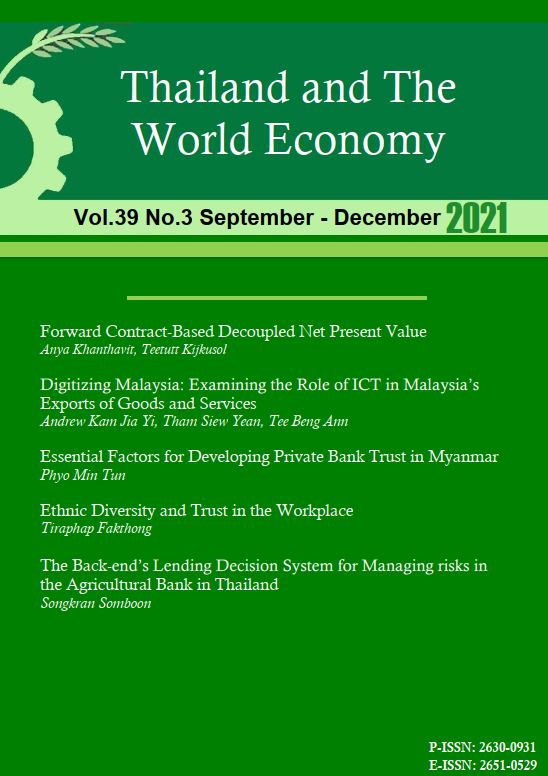Forward Contract-Based Decoupled Net Present Value
Keywords:
Capital budgeting, Project valuation, Risk premium, Time value of moneyAbstract
The decoupled net present value (DNPV) is a popular valuation method for long-term and complex investment projects. It is believed that this method provides a more accurate value than the traditional net present value method. Despite its popularity and accuracy, the DNPV method misvalues projects. This study shows DNPV’s misvaluation by the put–call parity relationship and proposes to replace DNPV’s synthetic insurance contract with a synthetic forward contract on the project’s free cash flow. The forward contract-based DNPV (FDNPV) values the project exactly. In the case study of a gold-mining project, the risk-neutral and FDNPV values are equal, whereas the traditional NPV and DNPV values are lower than the risk-neutral value. This finding demonstrates FDNPV’s exact valuation and DNPV’s misvaluation.
References
Abadie, L. M., & Chamorro, J. M. (2014). Valuation of wind energy projects: A real options approach. Energies, 7(5), 3218‒3255.
Almansa, C., & Martínez-Paz, J. M. (2011). What weight should be assigned to future environmental impacts? A probabilistic cost benefit analysis using recent advances on discounting. Science of the Total Environment, 409(7), 1305‒1314.
Biancardi, M., & Villani, G. (2017). Robust Monte Carlo method for R&D real options valuation. Computational Economics, 49(3), 481‒498.
Bowe, M., & Lee, D. L. (2004). Project evaluation in the presence of multiple embedded real options: Evidence from the Taiwan high-speed rail project. Journal of Asian Economics, 15(1), 71‒98.
Buehler, R., Freeman, A., & Hulme, R. (2008). Owning the right risk. Harvard Business Review, 86(9), 102‒110.
Cheah, C. Y. J., & Liu, J. (2006). Valuing governmental support in infrastructure projects as real options using Monte Carlo simulation. Construction Management and Economics, 24(5), 545‒554.
Coval, J. D., & Shumway, T. (2001). Expected option returns. Journal of Finance, 56(3), 983‒1009.
Dou, S., Liu, J., Xiao, J., & Pan, W. (2020). Economic feasibility valuing of deep mineral resources based on risk analysis: Songtao manganese ore-China case study. Resources Policy, 66, 101612.
Espinoza, R. D. (2014). Separating project risk from the time value of money: A step toward integration of risk management and valuation of infrastructure investments. International Journal of Project Management, 32(6), 1056‒1072.
Espinoza, D., & Morris, J. W. F. (2013). Decoupled NPV: A simple, improved method to value infrastructure investments. Construction Management and Economics. 31(5), 471‒496.
Espinoza, R. D., & Rojo, J. (2015). Using DNPV for valuing investments in the energy sector: A solar power project case study. Renewable Energy, 74, 44‒49.
Espinoza, D., Morris, J., Baroud, H., Bisogno, M., Cifuentes, A., Gentzoglanis, A.,… Vahedifard, F. (2020b). The role of traditional discounted cash flows in the tragedy of the horizon: Another inconvenient truth. Mitigation and Adaptation Strategies for Global Change, 25(4), 643–660.
Espinoza, D., Rojo, J., Cifuentes, A., & Morris, J. (2020a). DNPV: A valuation methodology for infrastructure and capital investments consistent with prospect theory. Construction Management and Economics, 38(3), 259–274.
Galera, A. L. L., & Soliño, A. S. (2010). A real options approach for the valuation of highway concessions. Transportation Science, 44(3), 416–427.
Garvin, M. J., & Cheah, C. Y. J. (2004). Valuation techniques for infrastructure investment decisions. Construction Management and Economics, 22(4), 373–383.
Haque, M. A., Topal, E., & Lilford, E. (2014). A numerical study for a mining project using real options valuation under commodity price uncertainty. Resources Policy, 39, 115–123.
Harrison, J. M., & Kreps, D. M. (1979). Martingales and arbitrage in multiperiod securities markets. Journal of Economic Theory, 20(3), 381–408.
Hull, J. C. (2018). Options, futures, and other derivatives (10th ed.). Delhi: Pearson India.
Li, D., Chen, H., Hui, E. C., Xiao, C., Cui, Q., & Li, Q. (2014). A real option-based valuation model for privately-owned public rental housing projects in China. Habitat International, 43, 125–132.
López-Marín, J., Gálvez, A., del Amor, F. M., & Brotons, J. M. (2021). The financial valuation risk in pepper production: The use of decoupled net present value. Mathematics, 9(1), 13.
Martínez-Ruiz, Y., Manotas-Duque, D. F., & Ramírez-Malule, H. (2021). Evaluation of investment projects in photovoltaic solar energy using the DNPV methodology. International Journal of Energy Economics and Policy, 11(1), 180–185.
Nguyen, N., Almarri, K., & Boussabaine, H. (2020). A risk-adjusted decoupled-net-present-value model to determine the optimal concession period of BOT projects. Built Environment Project and Asset Management, 11(1), 4–21.
Piel, J. H., Humpert, F. J., & Breitner, M. H. (2018). Applying a novel investment evaluation method with Focus on risk—A wind energy case study. In Fink, A., Fügenschuh, A., & Geiger, M. (Eds.), Operations research proceedings 2016. (pp. 193‒199). Cham, Switzerland: Springer.
Samis, M., & Davis, G. A. (2014). Using Monte Carlo simulation with DCF and real options risk pricing techniques to analyse a mine financing proposal. International Journal of Financial Engineering and Risk Management, 1(3), 264–281.
Schrader, P., Piel, J. H., & Breitner, M. H. (2018). Decoupled net present value—An alternative to the long-term asset value in the evaluation of ship investments? In Kliewer, N., Ehmke, J., & Borndörfer, R. (Eds). Operations research proceedings 2017. (pp. 271‒276). Cham, Switzerland: Springer.
Schwartz, E. (2013). The real options approach to valuation: Challenges and opportunities. Latin American Journal of Economics, 50(2), 163–177.
Shimbar, A., & Ebrahimi, S. B. (2017a). The application of DNPV to unlock foreign direct investment in waste-to-energy in developing countries. Energy, 132, 186–193.
Shimbar, A., & Ebrahimi, S. B. (2017b). Modified-decoupled net present value: The intersection of valuation and time scaling of risk in energy sector. Environmental Energy and Economic Research, 1(4), 347–362.
Stoll, H. R. (1969). The relationship between put and call option prices. Journal of Finance, 24 (5), 801–824.
Tversky, A., & Kahneman, D. (1991). Loss aversion in riskless choice: A reference-dependent model. Quarterly Journal of Economics, 106(4), 1039–1061.










